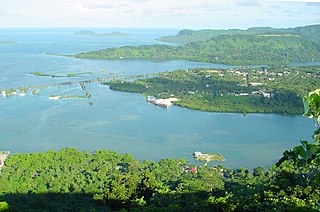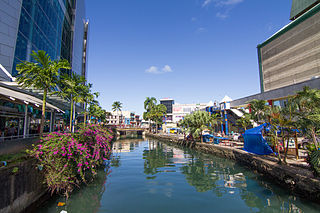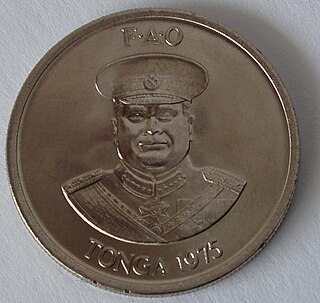Related Research Articles

The economy of American Samoa is a traditional Polynesian economy in which more than 90% of the land is communally owned. Economic activity is strongly linked to the United States, with which American Samoa conducts the great bulk of its foreign trade. Tuna fishing and processing plants are the backbone of the private sector, with canned tuna being the primary export. Transfers from the U.S. federal government add substantially to American Samoa's economic well-being. Attempts by the government to develop a larger and broader economy are restrained by Samoa's remote location, its limited transportation, and its devastating hurricanes.
The economy of the Cook Islands is based mainly on tourism, with minor exports made up of tropical and citrus fruit. Manufacturing activities are limited to fruit-processing, clothing and handicrafts.

The economic activity of the Federated States of Micronesia consists primarily of subsistence agriculture and fishing. The islands have few mineral deposits worth exploiting, except for high-grade phosphate. The potential for a tourist industry exists, but the remoteness of the location and a lack of adequate facilities hinder development. Financial assistance from the US is the primary source of revenue, with the US pledged to spend $1.3 billion in the islands in 1986–2001. Geographical isolation and a poorly developed infrastructure are major impediments to long-term growth.

The economy of Grenada is largely tourism-based, small, and open economy. Over the past two decades, the main thrust of Grenada's economy has shifted from agriculture to services, with tourism serving as the leading foreign currency earning sector. The country's principal export crops are the spices nutmeg and mace. Other crops for export include cocoa, citrus fruits, bananas, cloves, and cinnamon. Manufacturing industries in Grenada operate mostly on a small scale, including production of beverages and other foodstuffs, textiles, and the assembly of electronic components for export.

The economy of Martinique is mostly based in the services sector. Agriculture accounts for about 6% of Martinique's GDP and the small industrial sector for 11%. Sugar production has declined, with most of the sugarcane now used for the production of rum. Banana exports are increasing, going mostly to France. The bulk of meat, vegetable, and grain requirements must be imported, contributing to a chronic trade deficit that requires large annual transfers of aid from France. Tourism has become more important than agricultural exports as a source of foreign exchange. The majority of the work force is employed in the service sector and in administration.

Niue is a self-governing island country in free association with New Zealand. It is situated in the South Pacific Ocean and is part of Polynesia, and predominantly inhabited by Polynesians. The island is commonly referred to as "The Rock", which comes from the traditional name "Rock of Polynesia".
The Netherlands Antilles was an autonomous Caribbean country within the Kingdom of the Netherlands, which was formally dissolved in 2010.

The economy of Palau consists primarily of subsistence agriculture and fishing. The government is the major employer of the work force, relying heavily on financial assistance from the United States. The population enjoys a per capita income of more than twice that of the Philippines and much of Micronesia. Long-term prospects for the tourist sector have been greatly bolstered by the expansion of air travel in the Pacific and the rising prosperity of leading East Asian countries.

Once a single-crop agricultural economy, Saint Lucia has shifted to a tourism and banking serviced-based economy. Tourism, the island's biggest industry and main source of jobs, income and foreign exchange, accounts for 65% of its GDP. Agriculture, which was once the biggest industry, now contributes to less than 3% of GDP, but still accounts for 20% of jobs. The banana industry is now on a decline due to strong competition from low-cost Latin American producers and reduced European trade preferences, but the government has helped revitalize the industry, with 13,734 tonnes exported in 2018. Agricultural crops grown for export are bananas, mangoes, and avocados. The island is considered to have the most diverse and well-developed manufacturing industry in the eastern Caribbean.
The economy of Samoa is dependent on agricultural exports, development aid and private financing from overseas. The country is vulnerable to devastating storms, earthquakes, tsunamis. Agriculture employs two-thirds of the labor force, and furnishes 9% of exports, featuring coconut cream, coconut oil and copra. Outside a large automotive wire harness factory, the manufacturing sector mainly processes agricultural products. Tourism is an expanding sector; more than 70,000 tourists visited the islands in 1996 and 120,000 in 2014. The Samoan Government has called for deregulation of the financial sector, encouragement of investment, and continued fiscal discipline. Observers point to the flexibility of the labor market as a basic strength factor for future economic advances.

Vanuatu's economy is primarily agricultural; 80% of the population is engaged in agricultural activities that range from subsistence farming to smallholder farming of coconuts and other cash crops.

The economy of Fiji is one of the most developed among the Pacific islands. Nevertheless, Fiji is a developing country endowed with forest, mineral and fish resources. The country has a large agriculture sector heavily based on subsistence agriculture. Sugar exports and the tourism industry are the main sources of foreign exchange. There are also light manufacturing and mining sectors.

The government of the Marshall Islands is the largest employer, employing 30.6% of the work force, down by 3.4% since 1988. GDP is derived mainly from payments made by the United States under the terms of the amended Compact of Free Association. Direct U.S. aid accounted for 60% of the Marshall Islands' $90 million budget.
A per capita GDP of $3,200 ranks Solomon Islands as a lesser developed nation. Over 75% of its labour force is engaged in subsistence farming and fishing.

The economy of Saint Kitts and Nevis has traditionally depended on the growing and processing of sugar cane; decreasing world prices have hurt the industry in recent years. Tourism, export-oriented manufacturing, and offshore banking activity have assumed larger roles in Saint Kitts and Nevis. Most food is imported. The government has undertaken a program designed to revitalize the faltering sugar sector. It is also working to improve revenue collection in order to better fund social programs. In 1997, some leaders in Nevis were urging separation from Saint Kitts on the basis that Nevis was paying far more in taxes than it was receiving in government services, but the vote on cessation failed in August 1998. In late September 1998, Hurricane Georges caused approximately $445 million in damages and limited GDP growth for the year.

The economy of Dominica is reliant upon agriculture, particularly bananas, with the financial services industry and passport sales becoming increasingly the island's largest source of income. Banana production employs, directly or indirectly, upwards of one-third of the work force. This sector is highly vulnerable to weather conditions and to external events affecting commodity prices. The value of banana exports fell to less than 25% of merchandise trade earnings in 1998 compared to about 44% in 1994.

The economy of Antigua and Barbuda is service-based, with tourism and government services representing the key sources of employment and income. Tourism accounts directly or indirectly for more than half of GDP and is also the principal earner of foreign exchange in Antigua and Barbuda. However, a series of violent hurricanes since 1995 resulted in serious damage to tourist infrastructure and periods of sharp reductions in visitor numbers. In 1999 the budding offshore financial sector was seriously hurt by financial sanctions imposed by the United States and United Kingdom as a result of the loosening of its money-laundering controls. The government has made efforts to comply with international demands in order to get the sanctions lifted. The dual island nation's agricultural production is mainly directed to the domestic market; the sector is constrained by the limited water supply and labor shortages that reflect the pull of higher wages in tourism and construction. Manufacturing comprises enclave-type assembly for export with major products being bedding, handicrafts, and electronic components. Prospects for economic growth in the medium term will continue to depend on income growth in the industrialized world, especially in the US, which accounts for about one-third of all tourist arrivals. Estimated overall economic growth for 2000 was 2.5%. Inflation has trended down going from above 2 percent in the 1995-99 period and estimated at 0 percent in 2000.

The economy of the Northern Mariana Islands benefits substantially from financial assistance from the United States and tourism. The rate of funding has declined as locally generated government revenues have grown. An agreement for the years 1986 to 1992 entitled the islands to $228 million for capital development, government operations, and special programs. Since 1992, funding has been extended one year at a time. The Commonwealth received funding of $11 million for infrastructure, for FY96/97 through FY02/03, with an equal local match.
The economy of Guam depends mainly on US military spending and on tourist revenue. Over the past 20 years, the tourist industry grew rapidly, creating a construction boom for new hotels, golf courses and other tourist amenities. More than 1.1 million tourists visit Guam each year including about 1,000,000 from Japan and 150,000 from Korea. Setbacks in the 1990s include numerous super-typhoons, a M7.8 earthquake, and a Korean airline crash.

Tonga's economy is characterized by a large nonmonetary sector and a heavy dependence on remittances from the half of the country's population that lives abroad, chiefly in Australia, New Zealand, and the United States. Much of the monetary sector of the economy is dominated, if not owned, by the royal family and nobles. This is particularly true of the telecommunications and satellite services. Much of small business, particularly retailing on Tongatapu, is now dominated by recent Chinese immigrants who arrived under a cash-for-passports scheme that ended in 1998.
References
- ↑ "Worldwide in a Nutshell: Niue". American Philatelic Society. Retrieved 17 January 2023.
- ↑ Adressen som funkar på flera språk - Internetstiftelsen
- ↑ http://www.saob.se/artikel/?unik=N_0641-0219.Mc5e, https://ordnet.dk/ddo/ordbog?select=nu,1&query=nu, https://ordbok.uib.no/perl/ordbok.cgi?OPP=+nu&ant_bokmaal=5&ant_nynorsk=5&begge=+&ordbok=begge, http://gtb.inl.nl/iWDB/search?actie=article&wdb=ONW&id=ID3070&lemmodern=nu&domein=0&conc=true
- 1 2 3 4 "2018 Pacific Community Pocket Statistical Summary" (PDF).[ permanent dead link ]
- 1 2 3 4 5 6 7 8 9 10 11 12 13 Central Intelligence Agency (2015). World Factbook. ISBN 978-8379912131 . Retrieved 19 May 2016.
- ↑ "Niue" (PDF). June 2016. Retrieved 8 January 2017.
- ↑ United Nations Population Fund. "Niue" (PDF). Archived from the original (PDF) on 18 October 2016. Retrieved 19 May 2016.
- ↑ "2018/2019 Niue Budget Statement" (PDF).
- 1 2 3 4 5 "OEC – Niue (NIU) Exports, Imports, and Trade Partners".
- ↑ "New Zealand Foreign Affairs statistics".